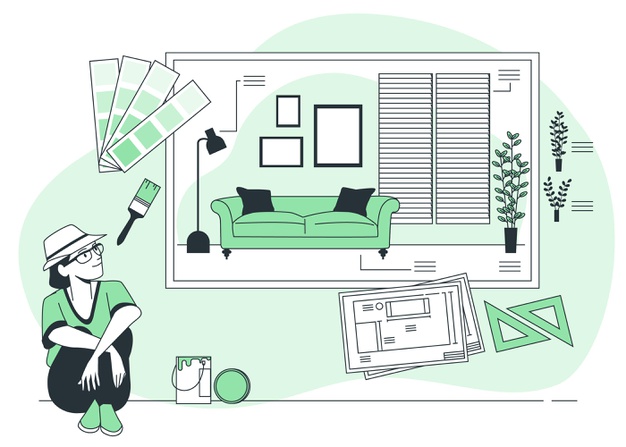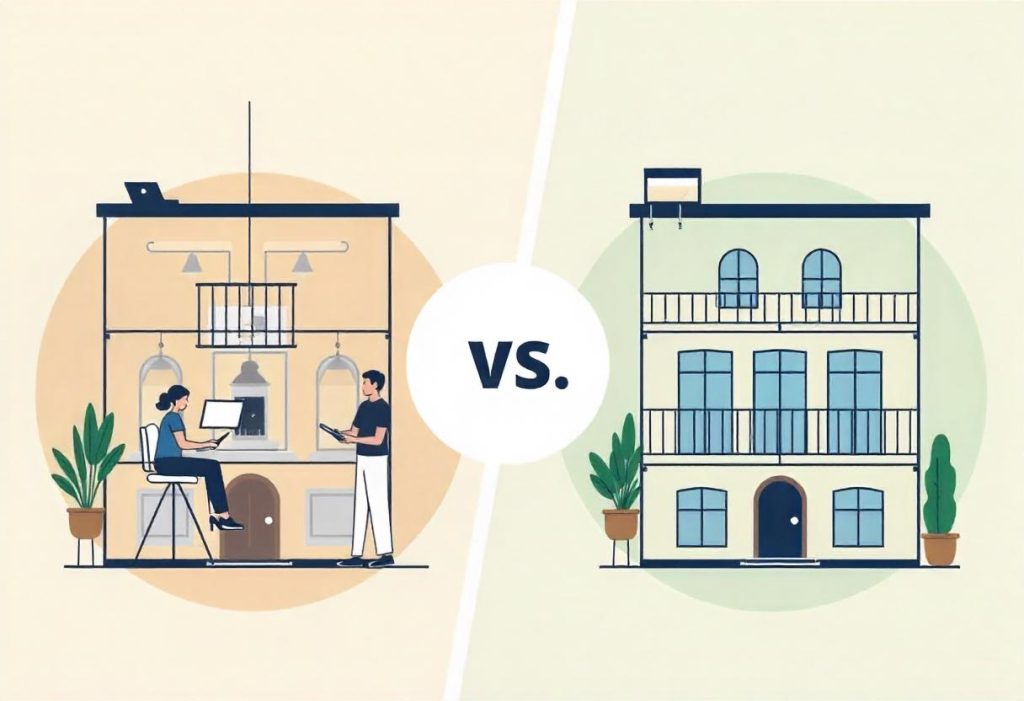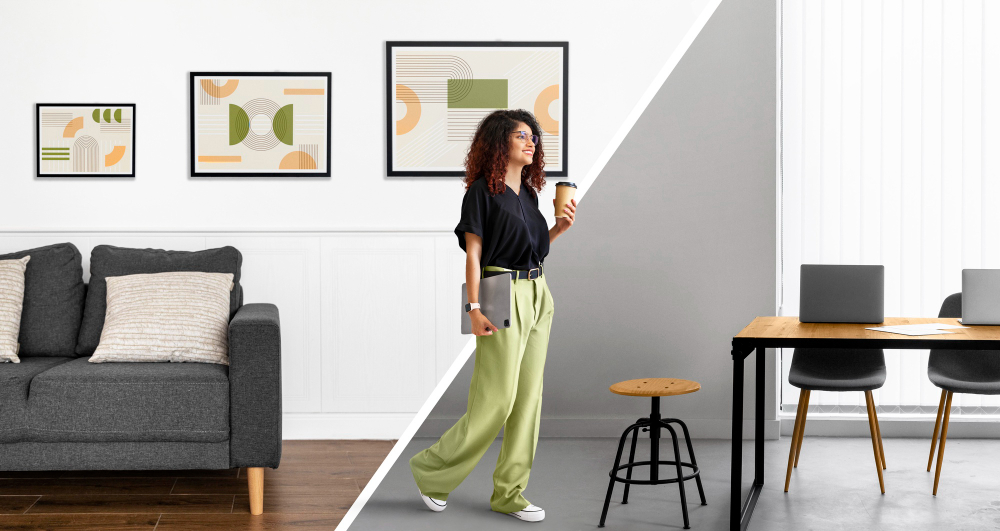Interior Designer vs. Architect: Understanding the Key Differences
Find out about the distinct roles of an architect vs. an interior designer so your building project proceeds seamlessly. Although both these professions are associated with residential & commercial building construction projects, they are quite different from one another.
An architect is usually associated with projects concerning the structural planning & construction of a building. An Interior Designer, on the other hand, deals with the interiors of a building – its aesthetic appeal, functionality, and stylistic features.
Read on to learn more about the roles of interior Designer vs. Architect, when to hire them, and which field you should opt for as a career.
What Does an Architect Do?
Architects develop the basic framework of a building, create a blueprint, and work in teams with city planners, builders, & engineers. Their daily tasks include a blend of technicality & creative planning –
- Conducting Site Studies – Architects are required to visit sites before construction. They analyze the space and understand the climate, surrounding structures, topography, and other environmental aspects.
- Structural & Conceptual Planning – The results of the site study are used to optimize natural light, ventilation, and stability. The structural planning includes creating a layout of the building and deciding the placements of walls, doors, & windows according to the client’s needs.
- Creating Blueprints & Overseeing Construction – They create 2D technical drawings with detailed plans for placements & measurements for the building. Architects are also responsible for supervising the construction process & collaborating closely with engineers and construction managers to ensure the project follows the safety standards and client requirements.
- Fulfilling Legal Requirements – Architects need to be aware of the building laws and regulations specific to the area and adhere to them. They are responsible for securing required permits and ensuring the construction complies with all the safety regulations.
What Does an Interior Designer Do?
Do you want free career counseling?
Ignite Your Ambitions- Seize the Opportunity for a Free Career Counseling Session.
- 30+ Years in Education
- 250+ Faculties
- 30K+ Alumni Network
- 10th in World Ranking
- 1000+ Celebrity
- 120+ Countries Students Enrolled
Interior Designers transform a building into the perfect home, office, or store. They make the insides of a building functional and visually appealing. They optimize the space, infusing relevant trends, design elements, and suitable color schemes.
- Space Planning & Layout Design – Interior Designers plan how to optimize the space and create layouts & floor plans to ensure maximum functionality and aesthetic appeal.
- Material & Furniture Selection – Each space has a unique aura. Interior designers tap into that, infuse trendy elements, and choose the perfect materials, decor, and furniture to elevate the space.
- Lighting Design & Color Scheme Selection – Color and lighting bring a space to life. They are carefully selected, considering aesthetics, functionality, and client requirements.
- Fulfilling Regulations-related requirements – Commercial, Healthcare, and Residential spaces must be accessible inside out. Designers ensure the interiors of these spaces meet all the safety & accessibility standards.
Read Also: Interior Design Courses: Your Gateway to a Thriving Career in Decorating

Key Difference between Interior Designer and Architect
Architects & Interior Designers are integral to any building project. However, they have distinct roles and scopes of work.
Book Now →
| Architecture | Interior Design | |
| Scope of Work | Structural Planning of a Building | Planning & Designing the Interiors of a Building |
| Skills Needed | Knowledge of Geometry, Physics, Engineering, Construction Computer Knowledge – CAD & other relevant software Space Planning & Structural Design Knowledge of Building Codes, Zoning Laws, & other important regulations | Knowledge of Geometry, Design, Color Theory, Trend Forecast, & Different aesthetics Computer Knowledge – CAD & other Design Software Lighting Design & Material Selection Knowledge of Sustainability & accessible designs |
| Minimum Qualification | B.Arch degree (5 Years) from a recognized college under the Council of Architecture (CoA) | B.Des/B.Sc. in Interior Design |
| License Required | Mandatory Registration with the Council of Architecture | There is no Mandatory licensing for interior designers in India |
| Primary Responsibilities | Site analysis, creating building plans, overseeing construction, taking care of relevant permits and laws | Interior space planning, layout design, and selecting materials, furniture & color scheme |
| When to Hire? | When a commercial/residential building is constructed OR when there is a structural renovation | When the Interiors of a building is to be designed/renovated |
Architect vs. Interior Designer – How to Choose the Right Career for Yourself?
The first & most basic step before you pursue any course is to ask yourself what you are passionate about.
Look at this list & check off the important factors before enrolling in a course.
- Consider Your Skills – Before you pursue a degree, know the skills you will need as an Architect vs. an Interior Designer. While the former focuses more on the engineering aspects and structure of the building, the latter focuses on creative functionality and design knowledge.
- Duration of Formal Training – B.Arch and M.Arch span a total of 5 years & 2 years respectively. B.Des/B.Sc in Interior Design is a 3-4-year course while M.Des/M.Sc spans 2 years. Know how the curriculums are spread over the duration and what covers your interest before finalizing a course.
- Scope & Salary – With a growing real estate and hotel/hospitality industry, architects and interior designers have expanding job opportunities. Leading companies hire these professionals for an elevated approach to building design and space planning.
Read Also: 10 Essential Skills You Gain from an Interior Design Course
Do you want free career counseling?
Ignite Your Ambitions- Seize the Opportunity for a Free Career Counseling Session.The average earnings of Interior designers working with different companies/freelancing lies between ₹6-24 LPA while that of an architect ranges from ₹9-20 LPA.
- Working in Teams – Architects oversee the construction of a building right from scratch. They work in large teams with city planners, engineers, construction managers, and builders. Interior Designers on the other hand work more closely with clients and contractors.
In some cases, Architects and Interior Designers work with the construction crew and contractors to enhance a building’s functional & aesthetic value.
Architects & Interior Designers – Projects That Need a Collaboration
So, since the roles of architects and interior designers are interdependent but quite different, do they work together at all?
Multiple projects require architects & design professionals to work closely with one another. Let us go over some of them in this section –
- Tailored & personalized home design projects often require architects and interior designers to work together to ensure the space is functional & creative inside out. This is a great way to make the interior and the exterior complement each other while also catering to the owner’s specific needs.
- Hotel & Hospitality projects mix strong structural designs with functional & appealing interiors. The look of the building & its interiors often follow a similar style, mood, or theme. For instance, palatial hotels & themed retreats usually have architects and designers working closely to ensure cohesiveness.
- Luxury Residential Complexes seamlessly blend creative structural planning with well-designed interiors. This makes the property more appealing and increases its market value.
Read Also: Sustainable and Stylish: Incorporating Eco-Friendly Practices in Interior Design Courses

Interior Designer vs. Architect Salary in India
When comparing the salaries of an interior designer and an architect, it’s essential to understand the unique expertise, experience, and qualifications each role demands. Interior designers focus on the aesthetics, functionality, and spatial arrangement of interior spaces. They often work with furniture, lighting, color schemes, and layouts to enhance a space’s appeal and practicality. In contrast, architects design entire buildings, focusing on structural integrity, safety, and sustainability.
| Factor | Interior Designer | Architect |
|---|---|---|
| Average Salary (India) | ₹3,00,000 – ₹8,00,000 per year | ₹4,50,000 – ₹12,00,000 per year |
| Education Requirement | Diploma or Bachelor’s in Interior Design | Bachelor’s or Master’s in Architecture (mandatory) |
| Licensing | Not mandatory, varies by state | Required, must clear Council of Architecture (COA) exam |
| Scope of Work | Focuses on interior aesthetics and space planning | Designs entire buildings, focusing on structure and safety |
| Experience Impact | Experienced designers earn more in luxury projects | Senior architects earn higher salaries on larger projects |
| Specialization Impact | Expertise in niches (e.g., sustainable, luxury design) boosts earnings | Specializations in fields like green architecture increase salary |
Salaries depend on factors like experience, city, and type of projects. Cities like Delhi, Mumbai, and Bangalore often offer higher pay for both professions.
Conclusion
Although people often confuse the roles of Interior Designer vs. Architect, they occupy distinct spaces in the industry.
Architects deal with the structure and form of a building, its stability, and functionality, and ensure the structure follows all the required legal & safety standards. They are responsible for building the structure as a whole.
Interior designers follow accessibility and safety norms, infuse trendy elements, and make the living space a sustainable and well-designed abode.
When deciding what career would be best for you, don’t forget to analyze the skills, scope of work, creativity, and technicality you will need. If you are an aspiring interior designer, check out the industry-standard, practical-oriented courses at AAFT.

AAFT has been providing the world with limitless creativity and expression since 1993! Through a dynamic and industry-driven curriculum, AAFT provides engaging and captivating articles to persuasive blogs and empowers its readers to explore diverse avenues of creative media education-related content.











